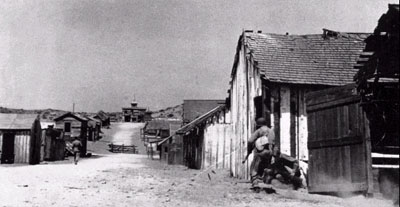The Army at Camp Cooke
The German
Blitzkrieg of World War II illustrated clearly that a new and more deadly
dimension had been added to modern warfare. In response to this new threat, the
U.S. Army sought improved training centers for the rapid development of its
armored and infantry forces. Having conducted a survey of the
Lompoc-Guadalupe-Santa Maria triangle, the Army acquired approximately 86,000
acres of land in March 1941. Most of the property was purchased while smaller
parcels were obtained by lease, license, and easements.
The property was comprised of parts of five Mexican land grants: Casmalia,
Guadalupe, Mission de la Purisíma, Ranchos Lompoc, and Todo Santos y San Antonio.
A sixth grant, Jesus Maria (42 acres), was transferred virtually intact to the
Army.(1) With its flat plateau, surrounding
hills, numerous nearby canyons, and relative remoteness from populated areas,
the Army was convinced that it had found the ideal training location.
Construction of the Army camp began in September 1941. Although its completion
was still months away, the installation was activated on October 5, and named
Camp Cooke in honor of Major General Philip St. George Cooke.
General Cooke was a cavalry officer, whose military career spanned almost half
a century beginning with his graduation from West Point in 1827 to his
retirement in 1873. He participated in the Mexican War, the Indian Wars, and
the Civil War. A native of Virginia, General Cooke remained loyal to the Union
during the Civil War. Perhaps his most enduring achievement came when as a
colonel during the Mexican War, he led a battalion of Mormons from Missouri to
California. The route led by Colonel Cooke in 1847 opened the first wagon route
to California and today the railroad follows much of the early wagon trails.
(1)The entire region had been home to
aboriginal Chumash Indians, but their influence gradually declined in the 19th
century. Meanwhile, after the overthrow of Spanish rule in 1821, the Mexican
government, seeking to protect its empty frontiers through colonization,
rewarded its army veterans and their descendants with grants of land. In the
years that followed, Anglo ranchers replaced many of the Mexicans as holders of
the grants through purchase, intermarriage, or outright chicanery. In the
1850s, Lewis T .Burton began purchasing land north of Santa Barbara and in 1853
became the owner of Rancho Jesus Maria. Since much of the ranch was located on
a mesa, the mesa became known as Burton Mesa By the turn of the century,
ownership of Rancho Jesus Maria had transferred to Edwin Jessop Marshall. A
wealthy businessman, Marshall added the land to his ranch empire that included
holdings in California, Arizona, and Mexico.
Although construction work at Camp Cooke continued well into 1942, troop
training did not wait. The 5th Armored Division rolled into camp in February
and March, and the steady roar of its tanks and artillery soon became part of
the daily scene. From then until the end of the war, other armored and infantry
divisions kept up the din before they too left for overseas duty.
Besides the 5th Division, the 6th, 11th, 13th, and 20th Armored Divisions as
well as the 86th and 97th Infantry Divisions, and the 2d Filipino Infantry
Regiment were all stationed at Cooke at varying times during the war. Also
trained at Cooke were an assortment of anti-aircraft artillery, combat
engineer, ordnance, and hospital units. Over 400 separate and distinct outfits
passed through Camp Cooke.
As the war progressed, German and Italian prisoners of war (the latter
organized into Service Units [ISUs]) were quartered at Camp Cooke. Both groups
were kept separate from each other in accordance with the Geneva Convention,
and worked on the post at various jobs including mechanical and civil
engineering services, clerical positions, food service, and the main laundry.
The Germans also worked in the local communities, mainly harvesting crops.
A maximum security army disciplinary barracks was constructed on post property
in 1946. Confined to the facility were recalcitrant military prisoners from
throughout the Army. When the main camp closed in June 1946, personnel at the
disciplinary barracks assumed the additional duty of installation caretakers.
Practically all the camp was then leased for agriculture and grazing.
From August 1950 to February 1953, Camp Cooke was used as a training
installation for units slated for combat in Korea, and as a summer training
base for many other reserve units. On February 1, 1953, the camp was again
inactivated with the U.S. disciplinary barracks assuming responsibility for
security and grounds maintenance. Four years later the military would return to
Camp Cooke, but this time the Air Force was here to stay.
The disciplinary barracks, meanwhile, was transferred to the U.S. Bureau of
Prisons to house civilian offenders in August 1959. Today it is known as the
United States Penitentiary at Lompoc.

The photo
above depicts the mock village at Camp Cooke that was used for urban warfare
training.
Credits:
Article:
Vandenberg
Air Force Base History Section
Photo: Gaviota Coast Conservancy. http://www.gaviotacoastconservancy.org/ranchos.html